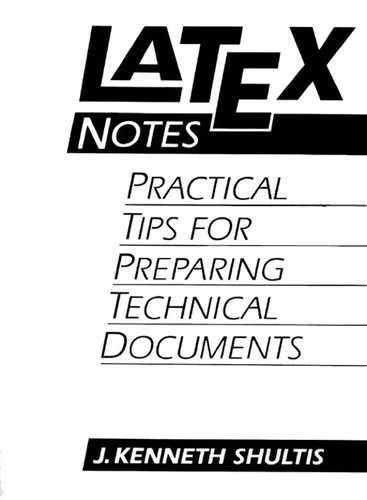Preface
A few years ago I discovered TEXand was immediately fascinated by its ability to produce beautifully typeset technical and scientific documents. More attractive still was the superset of TEX called LATEX which frees the user from much of the mundane chores required by TEX. The basic philosophy of LATEX is to free the writer from details of formatting, equation numbering, and the like, and allow him or her to concentrate on the document content. An excellent concept.
Unfortunately, a LATEX apprentice soon desires to step outside the strictures imposed by LATEX. Yet the road to becoming a TEX wizard is long and arduous, and, for most of us, there is not enough time to travel it. Rather, most LATEX users simply wish to find a quick fix to make some minor change in the way LATEX wants to do something. If you happen to live among friendly TEX wizards, you are fortunate; finding a fix then is often simply a matter of seeking an indulgence from a wizard. For those without such resources and who do not wish to undertake the studies, trials, and initiation rites to TEX wizardry, trying to cajole LATEX into doing things your way is often a frustrating experience. The refrain “I know it can be done, but I don’t know how” is often muttered.
TEX, from which LATEX is built, is a rich programming language and it is not surprising that many different solutions to a given problem can be found. For example, suppose you want to use a normal text hyphen in place of the longer minus sign in complex math formulas and also have it change size in superscripts and subscripts. As D. Hosek observes, your solution depends on the type of TEX person you are.
- A TEX user would use:
hbox{-} - A LATEX user would use:
mbox{-} - A TEXpert would use:
{ m-}
(It doesn’t work but TEXpert is a bogus term anyway.) - A TEXnician would use:
mathchar“002D - A TEX hacker would use:
mathchoice{hbox{-}}{hbox{-}}{hbox{sevenrm-}}{hbox{fiverm-}} - And a TEX wizard would use:
mathchar28717
(Why make the simple answer appear less than magical?)
These notes began as learning exercises and reference sheets as I attempted to understand LATEX. Although Leslie Lamport’s definitive reference LATEX: User’s Guide and Reference Manual is a very complete (if sometimes terse) description of LATEX, I often found it hard to find what I needed to know or to separate what was important to me from other esoteric features of LATEX. Thus my set of notes. Initially, they were just lists of things I had a hard time remembering but that I used regularly and that I could quickly find in my notes when needed. However, I soon started adding recipes and tricks as I struggled to extend LATEX or to understand some mysterious part of Lamport’s scripture.
The recipes and tricks included in these notes have been gleaned from many sources, including a few home grown efforts. The solutions may not always be the most elegant; rather, they represent tricks found to solve various formatting problems encountered during my initial efforts in using LATEX to prepare scientific documents. As such, these notes are also a personal diary of my frustrations with trying to understand Lamport’s brief explanations and with prodding LATEX to go beyond its original capabilities. They also represent the joys I experienced as I forced LATEX to my will. Finally, no attempt at completeness is made; the topics represent only a small part of what can be done with LATEX. The contents reflect those parts of LATEX that I have found most helpful while preparing technical documents.
In the hope that other beginners will have fewer struggles and greater pleasures as they mature to competent LATEX users, I offer these notes as a guide to those who have mastered the basics of LATEX and who are now ready to venture off the main LATEX highway to explore some of the less traveled paths afforded by this powerful typesetting program.
Before Using This Book
This book is based on the premise that its readers are both acquainted with the basics of LATEX and know how to run LATEX on their computer systems. If you have never used LATEX, you will find either one of the following publications will provide a good introduction to LATEX.
J. Hahn, LATEX for Everyone, Prentice Hall, New York, NY, 1991.
G. Maltby, An Introduction to TEX and Friends, freely available from TEX archives on the Internet (see Section 8.1.1).
Finally, no matter what level of LATEX user you are, a copy of one of the following comprehensive books is an indispensable reference work to have at your side as you prepare LATEX documents.
L. Lamport, LATEX: A Document Preparation System, Addison-Wesley, New York, NY, 1986.
A. Johnstone, LATEX Concisely, Prentice Hall, New York, NY 1992.
Acknowledgments
During the drafting of this book, I received help and suggestions from many of my colleagues and students at Kansas State University. To N. Dean Eckhoff, I extend special thanks for introducing me a few years ago to TEX and for sharing with me an initiate’s enthusiasm as we began to explore the capabilities of LATEX. Dick Faw and Ken Carpenter unselfishly gave me help with many LATEX problems, and for their many useful suggestions I am deeply appreciative. Finally, this book would not have been possible without the many contributors to the news group comp. text. tex on Internet from whom I have learned much and whose ideas and suggestions are reflected in many parts of this work. For the help from this vast pool of experts, I am especially grateful.
JKS
Kansas State University
